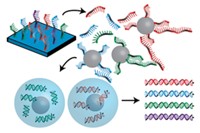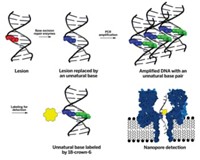Advertisement
Grab your lab coat. Let's get started
Welcome!
Welcome!
Create an account below to get 6 C&EN articles per month, receive newsletters and more - all free.
It seems this is your first time logging in online. Please enter the following information to continue.
As an ACS member you automatically get access to this site. All we need is few more details to create your reading experience.
Not you? Sign in with a different account.
Not you? Sign in with a different account.
ERROR 1
ERROR 1
ERROR 2
ERROR 2
ERROR 2
ERROR 2
ERROR 2
Password and Confirm password must match.
If you have an ACS member number, please enter it here so we can link this account to your membership. (optional)
ERROR 2
ACS values your privacy. By submitting your information, you are gaining access to C&EN and subscribing to our weekly newsletter. We use the information you provide to make your reading experience better, and we will never sell your data to third party members.
Sequencing
New chemistries for DNA sequencing
Binding reagents may lower error rate compared to sequencing by synthesis
by Laurel Oldach
May 30, 2023

Next-generation sequencing (NGS) has made analyzing DNA faster and cheaper, with effects felt in the lab, clinic, and beyond. A set of newly-launched technologies are offering a twist on the chemistry behind the process. Experts say these efforts may signal the first big change to NGS in years.
NGS relies on sequencing by synthesis: the sequence of a template DNA strand is determined by synthesizing a complementary strand from fluorescently labeled bases. After each base is incorporated by a polymerase and imaged, its fluorescent tag is removed and another base can be added. Now, companies are introducing sequencing platforms that separate fluorescent labeling from the extension of the complementary DNA strand, touting improvements in accuracy that result from optimizing each step.
Late in May, Element Biosciences published on the chemistry behind its platform for avidity sequencing, (Nat. Biotechnol., 2023, doi: 10.1038/s41587-023-01750-7). Biochemists define avidity as the cumulative strength of multiple interactions between two molecules. Matthew Kellinger, Element Biosciences cofounder and vice president of biochemistry, uses Velcro to explain. “One hook by itself can’t hold a lot. But if you put a person in [one of] those Velcro suits—that’s effectively avidity—they can jump and land on a wall.”
Element’s labeled reagents, called avidites, are built from several nucleotide moieties linked to a fluorescent core. Like individual Velcro hooks, each nucleotide can base pair with one identical copy of an amplified template, increasing the overall strength of the interaction.
Because they bind so tightly, Element says avidites work at 100-fold lower concentrations than typical NGS detection bases. After being imaged, they are washed away, and unlabeled nucleotides are used to extend the complementary strand, one base at a time. Element launched a sequencer commercially last spring, and says that its sequences are more accurate than competitors’ at less than half the cost per gigabase.
“I believe this is quite important, and represents an upgrade to nucleotide detection,” writes Don Baldwin, a molecular biologist at Fox Chase Cancer Center in an email to C&EN about Element’s sequencing platform.
Meanwhile, this spring PacBio launched a platform for what it calls sequencing by binding. Few details on the instrument’s chemistry are available, but according to an email from PacBio COO Mark Van Oene, this system also separates base detection and strand extension, using separate nucleotides to accomplish each step. “By doing so, chemistries optimized for fluorescent nucleotide binding, removal from the [polymerase] binding pocket, and cleavage of terminator nucleotides can be performed in distinct steps,” Van Oene writes.
Both platforms join a crowded market. Scott Tighe, who runs the genomics core lab at the University of Vermont, tested Element’s avidity platform against two other NGS sequencers for a variety of applications when his lab needed to purchase a new sequencer. He says they found its accuracy comparable to a sequencer from market dominating competitor Illumina at less than half the price per run. Tighe’s lab, however, opted to buy a sequencing-by-synthesis instrument from Singular Genomics because it offered more flexibility between large and small projects.
Justin Zook, who leads a genomics group at the National Institute of Standards and Technology, has found Element’s platform “really useful in polishing errors” in notoriously difficult-to-sequence repeated regions of the human genome. Zook says that with numerous new technologies emerging, which will be most commercially successful is anyone’s guess. “It’s hard to predict the future in the sequencing world.”




Join the conversation
Contact the reporter
Submit a Letter to the Editor for publication
Engage with us on Twitter